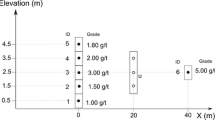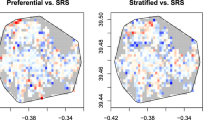Abstract
The estimation of geographical attributes is a crucial matter for many real-world problems, and the issue of accuracy stands out when the estimation is used for between-regions comparison. In this work, our concern is area attribute estimation in a GIS environment. We estimate the area attribute value with a mean Kriging technique, and the probability distribution of the estimate is derived. This is the best linear unbiased observed spatial population mean estimate and can be used in more relaxed situations than the block Kriging technique. Both theoretical analysis and empirical study show that the mean Kriging technique outperforms the ordinary Kriging, spatial random sampling, and simple random sampling techniques in estimating the observable spatial population mean across space.
Similar content being viewed by others
References
Christakos G, Bogaert P, Serre, M L. Temporal GIS. Berlin: Springer-Verlag, 2002
Christakos G. Modern statistical analysis and optimal estimation of geotechnical data. Eng Geol, 1985, 22: 175–200
Christakos G. Random Field Models in Earth Sciences. San Diego: Academic Press, 1992
Arrow K, Dasgupta P, Maler K G. Evaluating projects and assessing sustainable development in imperfect economics. Environ Resour Econ, 2003, 26: 647–685
Olea R A. Geostatistics for Engineers and Earth Scientists. Berlin: Springer, 1999
Bayraktar H, Turalioglu F S. A Kriging-based approach for locating a sampling site—in the assessment of air quality. Stochastic Environ Res Risk Assess, 2005, 19: 301–305
Brus D J, Gruijter J J D. Random sampling of geostatistical modeling? choosing between design-based and model-based sampling strategies for soil (with discussion). Geoderma, 1997, 80: 1–44
Cressie N. The origins of Kriging. Math Geol, 1990, 22: 239–252
Haining R. Estimating spatial means with an application to remote sensing data. Comm Stat, 1988, 17: 537–597
Saito H, McKenna S A, Zimmerman D A, et al. Geostatistical interpolation of object counts collected from multiple strip transects: Ordinary Kriging versus finite domain Kriging. Stochastic Environ Res Risk Assess, 2005, 19: 71–85
Christakos G. Recursive parameter estimation with applications in earth sciences. Math Geol, 1985, 17: 489–515
Courtier P, Talagrand O. Variational assimilation of meteorological observations with the direct and adjoint shallow-water equations. Tellus A, 1990, 42: 531–549
Daley R. Atmospheric Data Analysis. Cambridge: Cambridge University Press, 1991
Li X, Yeh A G. Modelling sustainable urban development by the integration of constrained cellular automata and GIS. Int J Geogr Inf Sci, 2000, 14: 131–152
Serre M L, Christakos G. BME studies of stochastic differential equations representing physical laws-Part II. 5th Annual Confer, Intern Assoc for Math Geol, Trondheim, Norway, 1999. 93–98
Christakos G. A Bayesian/maximum-entropy view to the spatial estimation problem. Math Geol, 1990, 22: 763–776
Christakos G. Spatiotemporal information systems in soil and environmental sciences. Geoderma, 1998, 85: 141–179
Kolovos A, Christakos G, Serre M L, et al. Computational BME solution of a stochastic advection-reaction equation in the light of site-specific information. Water Resour Res, 2002, 38: 1318–1334
Papantonopoulos G, Modis K.A. BME solution of the stochastic three-dimensional Laplace equation representing a geothermal field subject to site-specific information. Stoch Environ Res and Risk Assess, 2006, 20: 23–32
Courtier P, Derber J, Errico R, et al. Important literature on the adjoint, variational methods and the Kalman filter in meteorology. Tellus A, 1993, 45: 342–357
Derber J C. A variational continuous assimilation technique. Mon Wea Rev, 1989, 117: 2437–2446
Fillion L, Errico R M. Variational assimilation of precipitation data using moist-convective parameterization schemes: A 1D-VAR study. Mon Wea Rev, 1997, 125: 2917–2942
Ott W, Hunt B R, Szunyogh I, et al. A local ensemble Kalman filter for atmospheric data assimilation. Tellus A, 2004, 56: 415–428
Zhang C S, Fay D, McGrath D, et al. Use of trans-Gaussian Kriging for national soil geochemical mapping in Ireland. Geochem-Explor Environ Anal, 2008, 8: 255–265
Christakos G, Kolovos A, Serre M L, et al. Total ozone mapping by integrating data bases from remote sensing instruments and empirical models. IEEE Trans Geosci Remote Sensing, 2004, 42: 991–1008
Goodman J M. Space Weather and Telecommunications. Berlin: Springer, 2005
Reddy J N. Energy Principles and Variational Methods in Applied Mechanics. New York: John Wiley & Sons, 2002
Zhu A X, Hudson B, Burt J, et al. Soil mapping using GIS, expert knowledge, and fuzzy logic. Soil Sci Soc Am J, 2001, 65: 1463–1472
Cochran W G. Sampling Techniques. New York: John Wiley & Sons, 1997
Griffith D A, Haining R, Arbia G. Heterogeneity of attribute sampling error in spatial data sets. Geogr Anal, 1994, 26: 300–320
Haining R. Spatial Data Analysis: Theory and Practice. Cambridge: Cambridge University Press, 2003
Isaaks E H, Srivastava R M. An Introduction to Applied Geostatistics. Oxford: Oxford University Press, 1989
Grimmett G R, Stirzaker D R. Probability and Random Processes. Oxford: Oxford Science Publications, 1992
Shi W Z, Tian T. A hybrid interpolation method for the refinement of regular grid digital elevation model. Int J Geogr Inf Sci, 2006, 20: 53–67
Christakos G. Modern Spatiotemporal Geostatistics. Oxford: Oxford University Press, 2000
Krejcr P. Development of the Kriging method with application. Appl Math, 2002, 47: 217–230
Pardo-Ig’uzquiza E, Dowd P A. Empirical maximum likelihood Kriging: The general case. Math Geol, 2005, 37: 477–492
Atkinson P M. The effect of spatial resolution on the experimental variogram of airborne MSS imagery. Int J Remote Sensing, 1993, 14: 1005–1011
Brus D J, Gruijter J J D. A method to combine non-probability sample data with probability sample data in estimating spatial means of environmental variables. Environ Monitor Assess, 2002, 83: 303–317
Wang J F, Liu J Y, Zhuang D F, et al. Spatial sampling design for monitoring cultivated land. Int J Remote Sensing, 2002, 23: 263–284
Wang J F, Christakos G, Li L F. Sampling and Kriging spatial means: Efficiency and conditions. Sensors, 2009, 9: 5224–5240
Liu J Y, Zhang Z X, Zhuang D F, et al. Remote Sensing Analysis of Landuse Change in the 1990s (in Chinese). Beijing: Science Press, 2005
Wang J F, Christakos G, Hu M G. Modeling spatial means of surfaces with stratified non-homogeneity. IEEE Trans Geosci Remote Sensing, 2009, 47: 4167–4174
Author information
Authors and Affiliations
Corresponding author
Rights and permissions
About this article
Cite this article
Wang, J., Li, L. & Christakos, G. Estimating spatial attribute means in a GIS environment. Sci. China Earth Sci. 53, 181–188 (2010). https://doi.org/10.1007/s11430-009-0193-x
Received:
Accepted:
Published:
Issue Date:
DOI: https://doi.org/10.1007/s11430-009-0193-x




